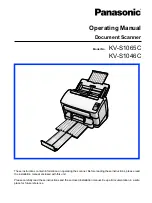
2-24
COPYRIGHT © CANON ELECTRONICS INC. 2008
CANON DR-X10C FIRST EDITION
CHAPTER 2 FUNCTION & OPERATION
The analog signals output from the CIS
unit are input to the reading PCB.
After those signals are converted into the
digital signals in the reading PCB, the dedi-
cated image processing IC performs the
shading correction and rearranges the order
of the data to align 3 lines.
According to the scanner settings, an
optical resolution between 600 dpi and 300
dpi can be selected. In case that the resolu-
tion is set at 300 dpi or less, 300dpi data are
output. The user selects either “Speed prior-
ity” or “Quality priority” for 400/600dpi. The
machine processes the image by using the
300dpi data for “Speed priority” and the
600dpi data for “Quality priority. ”
The image data output from the reading
PCB are input to the control PCB and proc-
essed by the dedicated scanner controller
(IC108).
First, the image data is rearranged in the
image input section.
Image processing section 1 changes the
resolution of the main-scanning direction in
accordance with the scanner settings in order
to convert the data into basic image data.
The basic image data are stored in the
SDRAM through the SDRAM interface.
SDRAM is 384 Megabytes in capacity and its
80% is used for storage.
And then, the 3-D color space processing
section performs the 3-D gamma correction to
improve the quality of colors.
Image processing section 2 changes the
resolution, performs the gamma correction (ad-
justment of brightness and contrast, and custom
gamma correction), the binary auto-brightness
adjustment (ABC), and the grayscale conver-
sion.
Image processing section 3 handles the
edge emphasis, binarizing (simple binarizing,
error diffusion, and high-speed text enhance-
ment).
In the JPEG module, the grayscale and
color data can be compressed in JPEG format.
When JPEG is selected, the image data size
is reduced by compression within this ma-
chine so that it can be transferred to the
computer in less time. As a result, more
documents can be read in a given time.
Finally, processed image data are sent
from the DMA I/F to the computer either
through the SCSI or USB interface.
Auto-size detection and skew correction
are processed according to the results of the
frame sensor processing section. Auto image
type detection is processed according to the
results of the pixel counter.
In case that the MultiStream is selected,
the image data stored in the SDRAM are
processed again in accordance with the sec-
ondary settings.
The following image processing is carried
out inside the computer.
•
Advanced text enhancement
•
Folio processing
•
Punch hole removal (if background is black)
•
Border removal (if background is black)
•
Text orientation recognition
















































